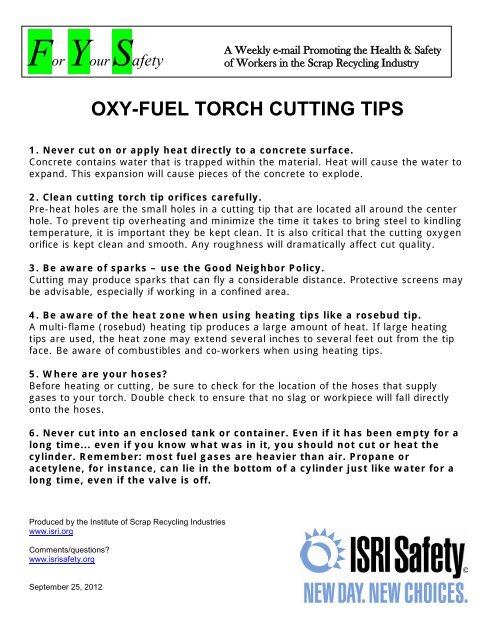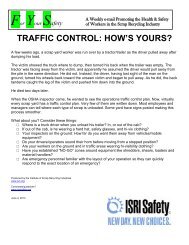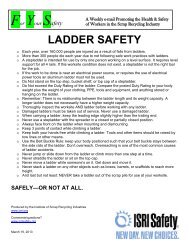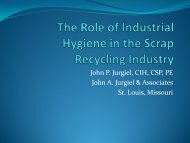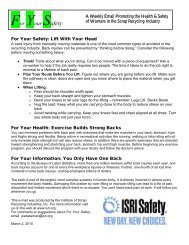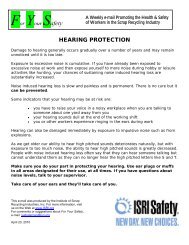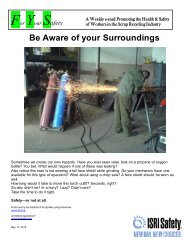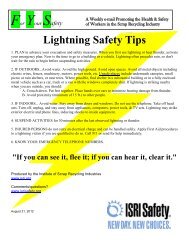OXY-FUEL TORCH CUTTING TIPS - ISRI Safety
OXY-FUEL TORCH CUTTING TIPS - ISRI Safety
OXY-FUEL TORCH CUTTING TIPS - ISRI Safety
Create successful ePaper yourself
Turn your PDF publications into a flip-book with our unique Google optimized e-Paper software.
For Your <strong>Safety</strong><br />
A Weekly e-mail Promoting the Health & <strong>Safety</strong><br />
of Workers in the Scrap Recycling Industry<br />
<strong>OXY</strong>-<strong>FUEL</strong> <strong>TORCH</strong> <strong>CUTTING</strong> <strong>TIPS</strong><br />
1. Never cut on or apply heat directly to a concrete surface.<br />
Concrete contains water that is trapped within the material. Heat will cause the water to<br />
expand. This expansion will cause pieces of the concrete to explode.<br />
2. Clean cutting torch tip orifices carefully.<br />
Pre-heat holes are the small holes in a cutting tip that are located all around the center<br />
hole. To prevent tip overheating and minimize the time it takes to bring steel to kindling<br />
temperature, it is important they be kept clean. It is also critical that the cutting oxygen<br />
orifice is kept clean and smooth. Any roughness will dramatically affect cut quality.<br />
3. Be aware of sparks – use the Good Neighbor Policy.<br />
Cutting may produce sparks that can fly a considerable distance. Protective screens may<br />
be advisable, especially if working in a confined area.<br />
4. Be aware of the heat zone when using heating tips like a rosebud tip.<br />
A multi-flame (rosebud) heating tip produces a large amount of heat. If large heating<br />
tips are used, the heat zone may extend several inches to several feet out from the tip<br />
face. Be aware of combustibles and co-workers when using heating tips.<br />
5. Where are your hoses?<br />
Before heating or cutting, be sure to check for the location of the hoses that supply<br />
gases to your torch. Double check to ensure that no slag or workpiece will fall directly<br />
onto the hoses.<br />
6. Never cut into an enclosed tank or container. Even if it has been empty for a<br />
long time... even if you know what was in it, you should not cut or heat the<br />
cylinder. Remember: most fuel gases are heavier than air. Propane or<br />
acetylene, for instance, can lie in the bottom of a cylinder just like water for a<br />
long time, even if the valve is off.<br />
Produced by the Institute of Scrap Recycling Industries<br />
www.isri.org<br />
Comments/questions?<br />
www.isrisafety.org<br />
September 25, 2012
Para su seguridad<br />
Un correo electrónico semanal para promover la salud y<br />
la seguridad de los trabajadores de la industria del<br />
reciclaje de chatarra<br />
CONSEJOS PARA CORTE CON SOPLETE<br />
OXIGAS<br />
1. Nunca corte o aplique calor directamente a una superficie de concreto.<br />
El concreto contiene agua que está atrapada dentro del material. El calor causará que el<br />
agua se expanda. Esta expansión causará que exploten piezas del concreto.<br />
2. Limpie cuidadosamente los orificios de la punta del soplete.<br />
Los orificios de precalentamiento son pequeños agujeros en la punta de corte que están<br />
ubicados alrededor del orificio central. Para evitar que la punta se recaliente y minimizar<br />
el tiempo que toma llevar al acero a temperatura de encendido, es importante<br />
mantenerlos limpios. También es fundamental que el orificio de oxígeno de corte se<br />
mantenga limpio y suave. Cualquier irregularidad afectará profundamente la calidad del<br />
corte.<br />
3. Tenga cuidado con las chispas; use la consideración de un buen vecino.<br />
El corte puede producir chispas que pueden volar una distancia significativa. Es posible<br />
que se aconseje usar pantallas protectoras, especialmente si se trabaja en un área<br />
cerrada.<br />
4. Tenga cuidado con la zona de calor cuando use puntas de calentamiento tipo<br />
capullo de rosa.<br />
La punta de calentamiento multillama (capullo de rosa) produce una gran cantidad de<br />
calor. Si se usan puntas de calentamiento grandes, la zona de calor puede extenderse<br />
desde varias pulgadas a varios pies desde la cara de la punta. Tenga cuidado con los<br />
combustibles y con los compañeros de trabajo cuando use puntas de calentamiento.<br />
5. ¿Dónde están sus mangueras?<br />
Antes de calentar o cortar, asegúrese de controlar la ubicación de las mangueras que<br />
abastecen de gases a su soplete. Vuelva a controlar para asegurarse de que ninguna<br />
escoria o pieza de trabajo pueda caer directamente sobre las mangueras.<br />
6. Nunca corte un tanque o contenedor cerrado. Aun si ha estado vacío por un<br />
largo tiempo... incluso si sabe qué había en el interior, no debe cortar o<br />
calentar el cilindro. Recuerde: la mayoría de los gases combustibles son más<br />
pesados que el aire. El propano o el acetileno, por ejemplo, pueden permanecer<br />
en el fondo de un cilindro por un largo tiempo al igual que el agua, incluso<br />
cuando la válvula está cerrada.<br />
Producido por el Institute of Scrap Recycling Industries<br />
www.isri.org<br />
¿Tiene comentarios o preguntas?<br />
www.isrisafety.org<br />
25 de septiembre de 2012
For Your <strong>Safety</strong>/For Your Driving<br />
Training Session Sign-In Sheet<br />
Topic_________________________________________<br />
Instructor____________________________________<br />
Location______________________________________<br />
Date ___________________________
Para Su Seguridad/Para Su Conducción<br />
Hoja De Inscripción Para La Sesión de Capacitación<br />
Tema_________________________________________<br />
Instructor____________________________________<br />
Ubicación_____________________________________<br />
Fecha ___________________________


